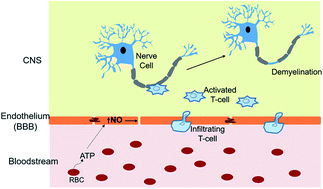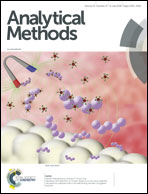Steroid inhibition of erythrocyte-derived ATP reduces endothelial cell production of nitric oxide in a 3D-printed fluidic model†
Abstract
Multiple sclerosis (MS) is a disease of the central nervous system affecting over 2.5 million people worldwide. MS is characterized by blood brain barrier (BBB) damage and demyelination of axons, which causes brain lesions leading to complications such as numbness and blurred vision. Steroid medications are available to help treat symptoms of MS, and although the mechanism of action of steroids is known for most cells, it is not completely understood with respect to red blood cells (RBCs). Here, we show that the steroids estriol and prednisolone effect RBC ATP release and downstream endothelial NO production, which may be a mechanism of action of steroids in the bloodstream. Our results suggest that while RBCs obtained from people with MS release significantly more ATP than RBCs from healthy people (healthy: 216 ± 11 nM, MS: 321 ± 18 nM), a significant decrease up to 183 nM in ATP release is measured due to the presence of physiological levels of estriol or prednisolone. Further analysis measured a 31% decrease in endothelial nitric oxide (NO) production from endothelial cells in contact with RBCs treated with estriol or prednisolone. These results suggest that steroids may have an additional mechanism of action in the bloodstream through their ability to attenuate RBC ATP release. ATP stimulates NO production in vivo, and while high levels of NO are detrimental to the BBB, it follows that hindering the amount of ATP in the bloodstream would decrease the BBB damage and demyelination in MS.

- This article is part of the themed collection: Microfluidic systems with societal impact


 Please wait while we load your content...
Please wait while we load your content...